 |  |
By Greg Niemann
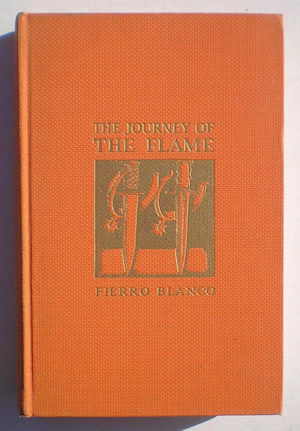
While most Baja-related books I’ve read have been non-fiction, I’ve found some fascinating fiction as well. There is one historical-fiction Baja book that is not only engrossing and captivating, but came wrapped in its own mystery. Adhering to factual events, people, and places, it introduces readers to much of the Baja California peninsula.
Published in 1933, The Journey of the Flame was allegedly authored by someone named Antonio de Fierro Blanco. The historical novel covers one year of the life of young red-headed Don Juan Obrigon, known as Juan Colorado (The Flame). He was allegedly born in the “south of Lower California” in 1798, traveled throughout California and died near Rosario, Mexico in 1902.
On the night of his 100th birthday, with hair still flaming red, he tells his story to assembled relatives and guests. He describes his travels as a boy of twelve in 1810, when he accompanied the Spanish viceroy of Baja California from the southern tip of Baja California to Monterey in the future U.S. state of California.
While weaving the entertaining story about the adventures of the horseback expedition, the storyteller introduces his audience to real historical people and events.
As the entourage traveled north, Juan described things as he saw them, sometimes displaying a sardonic wit along with historical significance. For example, upon reaching Loreto, he wrote “Loreto - as everyone knows who had been there, since every viejito you meet will tell you at least once - is the oldest town in the three Californias, and was founded by the Virgin’s direct order.”
He added, “Two things here seemed to me fantastic....At Loreto they boasted of having had the first boarding school for girls in the Californias, caring for six hundred Indian girls. They were taught to wear clothes, cook Spanish food, and care for a house; after which they were turned loose to live without clothes, eat bugs, and dwell in the open without roof in summer and winter.
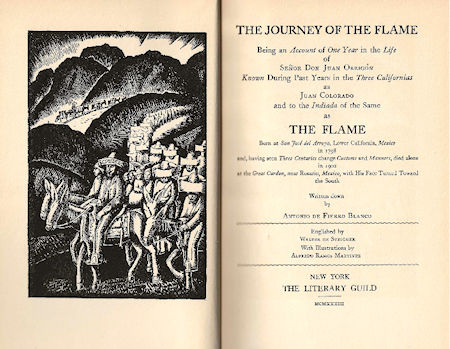
“The second was that I counted in their library five hundred books, though there were then but four hundred souls in Loreto, including all bloods, of whom only priests and empleados could read.”
As enlightening and enjoyable as the book is, it’s the intriguing back story about its publishing, however, that made The Journey of the Flame a real Baja mystery. Fierro Blanco didn’t exist and the actual author was unknown!
Presented to the publisher Houghton Mifflin in 1933 through an intermediary, there was an understanding that if any attempts were made to learn the true identity of the author, the book would be withdrawn and the manuscript destroyed. While the publishers agreed and published the book, some people tried to learn the identity of the author.
One determined sleuth was Harrison Leussler, a Houghton Mifflin western sales representative who did some detective work.
On the book’s title page it reads, “Written down by Antonio de Fierro Blanco” and below that “Englished by Walter de Steiguer.” Leussler located de Steiguer in Glendale, California but learned nothing from the evasive de Steiguer. He also did not discover an earlier business connection between de Steiguer and the book’s author.
Walter G. de Steiguer had been proprietor of the California China Products Company, a company founded in National City that made Spanish Pottery. The clue not discovered by Leussler from de Steiger was that the company was founded by, and formerly owned by, Walter Nordhoff, a member of a distinguished literary family.
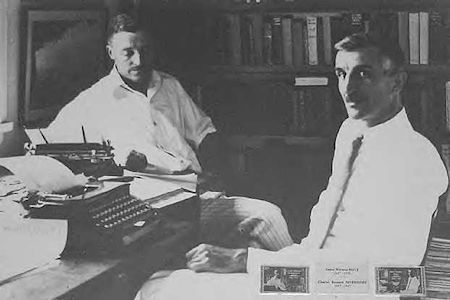
Family patriarch Charles (the elder) Nordhoff (1830-1901), was a noted author, adventurer, and editor at Harper’s Magazine. He was the father of Walter Nordhoff (1858-1937), and of Evelyn Hunter Nordhoff (1865–1898), America's first female bookbinder and printmaker.
Walter Nordhoff (1858-1937) was a mining engineering graduate from Yale University who became a businessman and journalist. He was also foreign correspondent for the New York Herald, serving in locations around the world.
In 1887 Walter accompanied his father Charles to Lower California as guests of the Mexican International Company which wanted to colonize some of its 18 million acres of land there.
Charles had penned over 20 books, including one of the most popular and influential books on California: California: A Book for Travelers and Settlers. Published in 1872, it described California as the proverbial “land of milk and honey” and sold three million copies greatly aiding California migration.
After his Baja visit, at the behest of the International Company, Charles Nordoff published Peninsular California in 1888 (Harper Brothers, New York, 1888). As compensation for the publicity, the grateful International company presented him with a 50,000-acre ranch (Rancho Ramajal) on Todos Santos Bay at Punta Banda, 15 miles south of Ensenada.
Son Walter gave up his traveling, and with his wife Sarah spent the next 20 years (until the Mexican revolution in 1910) managing the ranch. He moved to the San Diego area where with his son Charles B. and another partner, he established the pottery company in 1911.
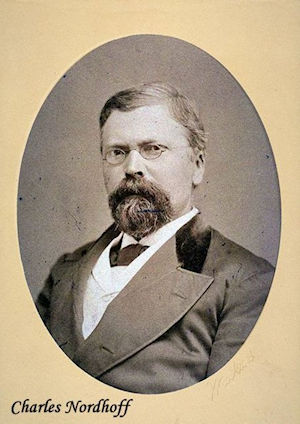
The company manufactured earthenware and ceramic tile from clay deposits in San Diego and Lower California. It was the first porcelain factory west of Columbus, Ohio. Turning his interests in the company over to de Steiguer, Walter then settled in Santa Barbara in 1923.
Two sons of Walter Nordhoff continued the family writing tradition, Charles Bernard Nordhoff (1887-1947), and Franklin W. Nordhoff (who wrote Fruit of the Earth).
The most familiar and popular Nordhoff work was the historical novel trilogy Mutiny on the Bounty (1932), Men Against the Sea (1934), and Pitcairn's Island (1934) co-written by Charles Bernard Nordhoff and James Norman Hall.
Seeking the real author of The Journey of the Flame, Harrison Leussler, that determined sales representative for Houghton Mifflin, had not succeeded in unmasking Antonio de Fierro Blanco. Finally, while taking a book order in Santa Barbara, he overheard someone’s guess as to the author’s identity. He dismissed the suggestion as being too preposterous.
It wasn’t until many months later, when the mysterious Fierro Blanco published his second novel (Rico, Bandit and Dictator, Houghton Mifflin Company, Boston, 1934), under the same shroud of secrecy did he hear the same name. The name was “Nordhoff.” It couldn’t be! The famed author Charles B. Nordhoff had been in the South Pacific working on his trilogy.
Could he have been a relative? Leussler searched “Who’s Who,” even looking at past issues and comparing biographies. In Charles B. Nordhoff’s biography, he found a line had been crossed out of the newer editions. The line read “brought up on his father’s ranch in Lower California.”
Aha. He knew that the person who penned The Journey of the Flame must have lived in Baja California to be that familiar with it. And it looked like someone was trying to cover his tracks.
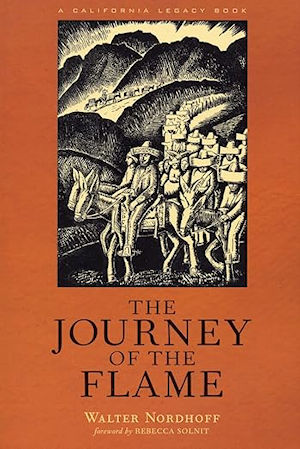
Charles Bernard Nordhoff’s father, Walter Nordhoff, while a former journalist, had never authored a book. Plus, he was in his seventies. Had he become a late-life author? Braced with a name this time, de Steiguer relented and agreed that indeed, Walter Nordhoff was the late-life author Fierro Blanco.
Walter Nordhoff was found living in Santa Barbara and admitted it. Apparently he did not want to capitalize on the name of neither his father, nor of his son who was at the peak of his fame with The Mutiny on the Bounty.
Along with his refraining from capitalizing on the name, Walter was also a very private person and wanted to avoid the limelight. Another supporting reason was that the Baja ranch was not confiscated during the Revolution and he did not want to jeopardize it by having his true name appear in a book about that area.
Baja bibliophiles recognize The Journey of the Flame for what it is, an outstanding book in a very realistic setting. The book’s success was immediate and wide-spread and became a Literary Guild selection.
Considered a masterpiece of California literature by an entire generation of historians, geographers, and literary critics, it was 18 years after Walter Nordhoff’s 1937 death, before Houghton Mifflin republished the book under his true name. The Journey of the Flame has been long out of print but is now available in a new and beautifully designed California Legacy edition.
All three generations of the Nordhoff family became influential, having California business interests and owning several homes in California.
For the Nordhoff contributions to California, Nordhoff High School in Ojai, and Nordhoff Street in the San Fernando Valley are named for Charles. In fact, the town of Ojai was called Nordhoff until 1917. To readers everywhere, the three generations of authors Nordhoff have rewarded them with untold adventures.

Great site to get your insurance from the Baja experts.

Excellent service! Michelle made it so easy for me to purchase a 6 month mexican policy for all of...

This a solid way to go for the Baja and Sonora travel. Reasonable rates, easy to apply and pay....